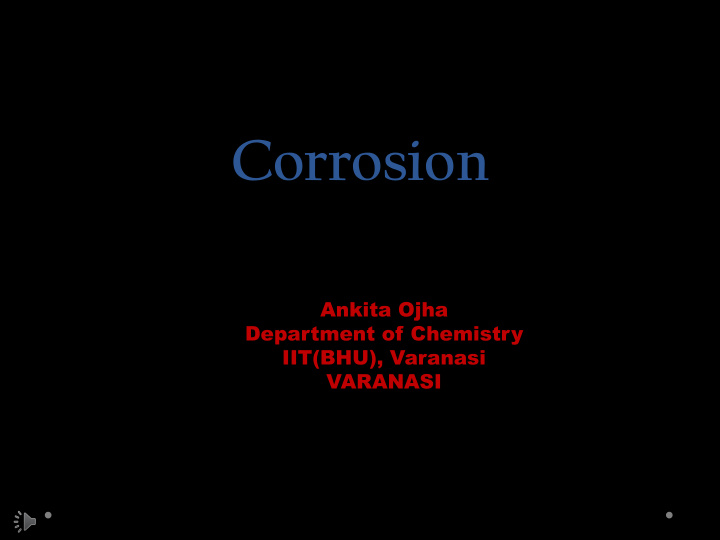



Corrosion Ankita Ojha Department of Chemistry IIT(BHU), Varanasi VARANASI
What is Corrosion??? Corrosion is an irreversible interfacial reaction of a material with its environment which results in consumption of the material or in dissolution of a component of environment https://upload.wikimedia.org/wikipedia/commons/thumb/ b/bb/Rust_and_dirt.jpg/220px-Rust_and_dirt.jpg into the material.
• Some available pictures on corrosion from internet http://nhanvietgroup.vn/wp- content/uploads/2018/03/Corr osion-Control.jpg https://www.bendplating.com/wp- content/uploads/2017/03/rust-1- e1488346306943-1288x724.jpg CORROSION is the Cancer of metal health
Corrosion is vulture of metallurgy. Corrosion is the greatest killer of metals. Corrosion is the extractive metallurgy in reverse. Corrosion is a silent wrecker, operating at all times, at all levels and in all establishments. Corrosion is an epidemic that leads to mass destruction of metals.
THERMODYNAMICS OF CORROSION IMPOSED EXTRACTION MINERALS METAL [oxides, sulfides, hydroxides, + ENERGY [higher energy state] carbonates, etc. - Δ G = nFE CORROSION NATURAL GOLD, Mined from the Earth in native form NO CORROSION Stored in underground vaults as GOLD
FACTORS INVOLVED IN CORROSION Characteristics Characteristic of of Metal Environment Composition, Chemical nature, atomic structure, concentration of crystallographic structures, microscopic reactive species, heterogeneities, stress temperature, (residual, tensile, velocity of compressive, cyclic) impingement, etc. etc. Characteristics of Interfacial Reaction Kinetics of metal , Oxidation or dissolution, kinetics of reduction of species in solution; nature and location of corrosion products; film growth and film dissolution, etc.
Electrochemical Theory Galvanic or concentration cell is formed at metal-environment interface. Part of metal becomes anodic Electrons released are taken up by a M M n+ + ne - depolarizer. Which can be More likely to happen where Hydrogen ions Anodic impurity is present 2H + + e - H 2 Metal is stressed Oxygen 2H 2 O + O 2 + 4e - 4 OH - Oxygen deprived sites Surface film of corrosion product being destroyed by Cations of a more noble metal M x+ + xe - M OH - ions
In electrochemical theory of corrosion at the surface of metal oxidation takes place and that point behaves as an anode. The electrons that are released at this anodic surface further move through the metal and reach to an another point on the metal and reduces oxygen at that spot in presence of H + (which is believed to be available from H 2 CO 3 formed due to dissolution of carbon dioxide from air into water in moist air condition of atmosphere. Hydrogen ion in water may also be available due to dissolution of other acidic oxides from the atmosphere). This point hence behaves as a cathode.
Mixed potential theory • Anodes and cathodes are not discrete. • Both oxidation and reduction reactions occur on the same surface – whole surface acts as mixed electrodes • An electrochemical reaction consists of more than one oxidation and reduction reactions occurring simultaneously. M + nH + M n+ + n / 2 H 2 M M n+ + ne H 2 2H + + 2e M n+ + ne M 2H + + 2e H 2 At any time: TOTAL RATE OF OXIDATION = TOTAL RATE OF REDUCTION
Evans diagrams
Corrosion preventive techniques • Galvanization & tinning • Phosphatization & anodization General • Paints & Polymers • Enamels Galvanization or galvanizing (also spelled galvanisation or galvanising) is the process of applying a protective zinc coating to steel or iron, to prevent rusting. https://i.pinimg.com/736x/49/dc/69/49dc699d0a64b4 687c1b1455072e04cc--steel-structure-dip.jpg
• Dealloying and Further Alloying Metallurgical • Heat treatment Dealloying is a technique for leaching out less noble metal from an alloy and then this metal is added with more
• Proper designing Mechanical • Avoiding formation of galvanic couple • Anodic Protection • Cathodic Protection Electrochemical • Corrosion Inhibitors
Details will be updated soon in the video
Recommend
More recommend